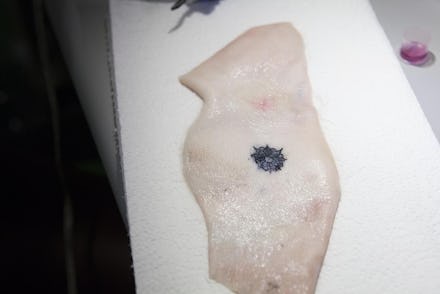Scientists created tattoos that change color to give you real-time data about your body

The future of tattoos could give you a life-saving warning when your blood sugar dips.
People get tattoos for decorative or commemorative reasons, but now teams at MIT Media Lab and Harvard Medical School have collaborated to give tattoos a new function: delivering real-time data about your body. The researchers have created a tattoo ink that reacts to your body’s chemistry to change colors as your body changes.
Called DermalAbyss, the work is the brainchild of MIT Media Lab researcher Katia Vega, who worked with Harvard Medical School to create four types of biosensors that react to three types of biochemical information. These unconventional inks inject biosensors below the skin to gather measurements on interstitial fluid in your skin and change in color when glucose (blue and brown scale), sodium (varying intensities of fluorescence) or pH levels (purple and pink scale) change in your body.
“DermalAbyss presents a novel approach to biointerfaces in which the body surface is rendered an interactive display,” the team writes on their website. “Traditional tattoo inks were replaced with biosensors whose colors change in response to variations in the interstitial fluid. It blends advances in biotechnology with traditional methods in tattoo artistry.”
Vega is no stranger to the intersection of beauty and technology. She has worked on an array of projects from smart fake eyelashes and conductive makeup to RFID-enabled nail polish. With DermalAbyss, she’s using skin as her medium and testing it on ex vivo pig skin models.
“I wanted to go deeper, not just on the top of your epidermis,” Vega told Co.Design.
This technology could serve the average consumer similar to how wearables work: They can monitor the body and provide people with data. Take someone who has diabetes — they could replace pricking their finger to monitor blood sugar levels with the tattoo biosensor that fluctuates from pink to purple to deliver information about glucose levels.
"The DermalAbyss creates a direct access to the compartments in the body and reflects inner metabolic processes in a shape of a tattoo," write the researchers.